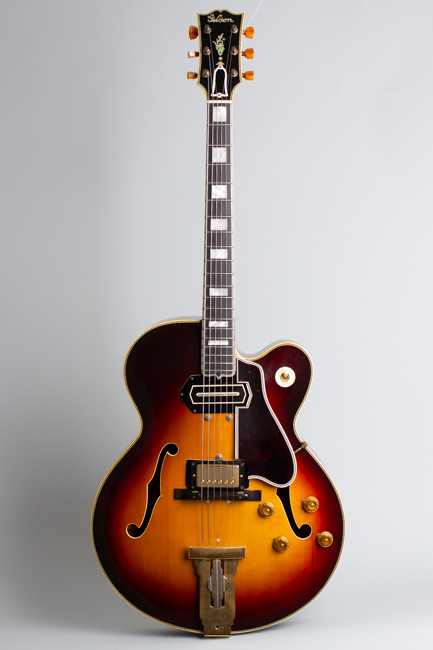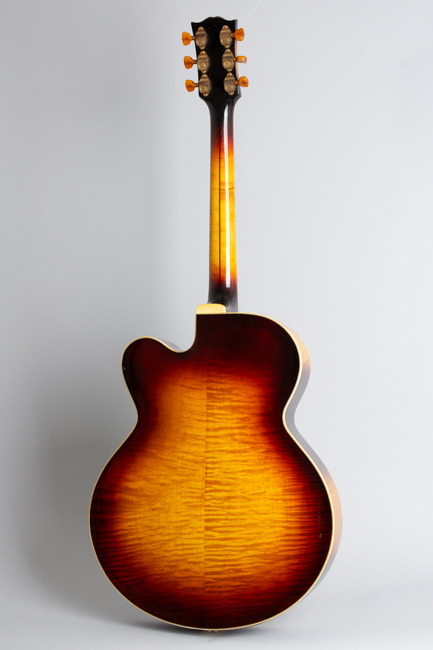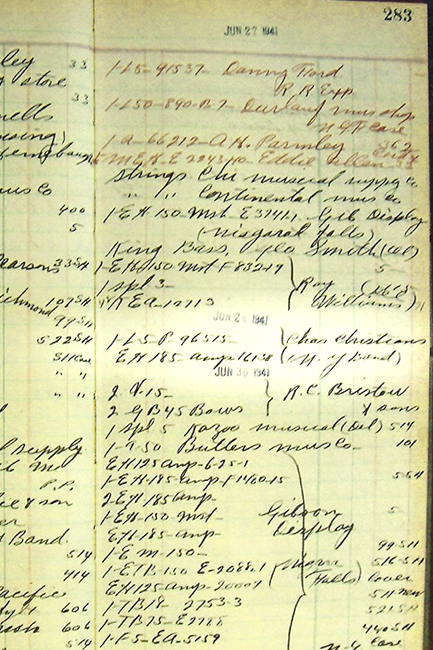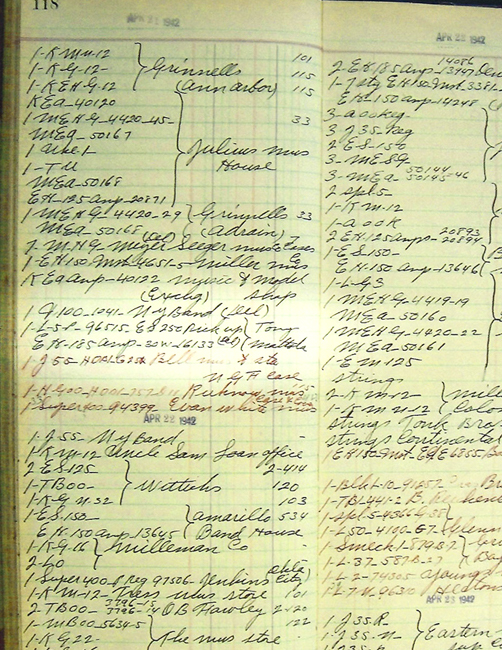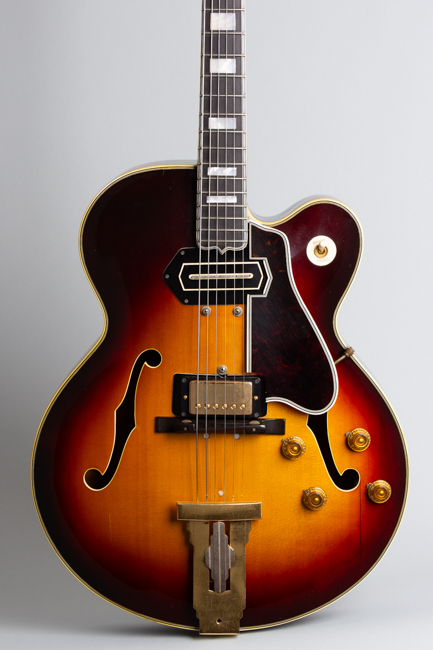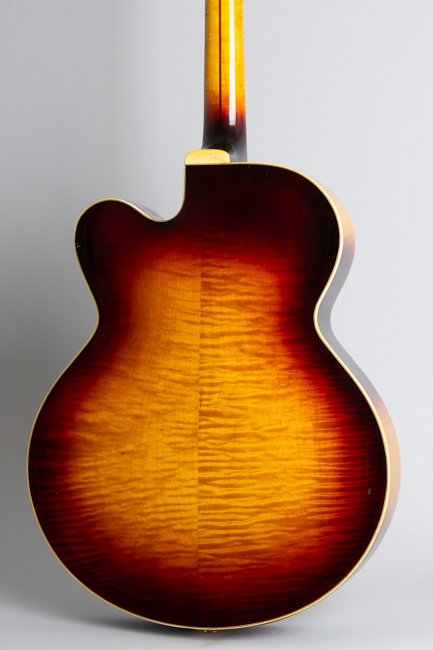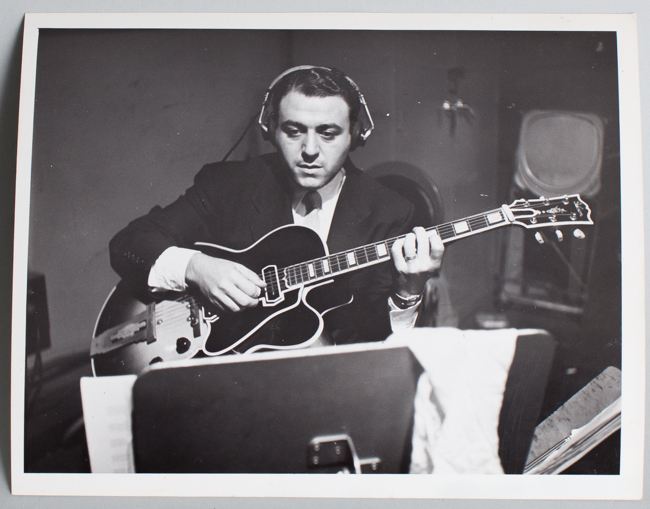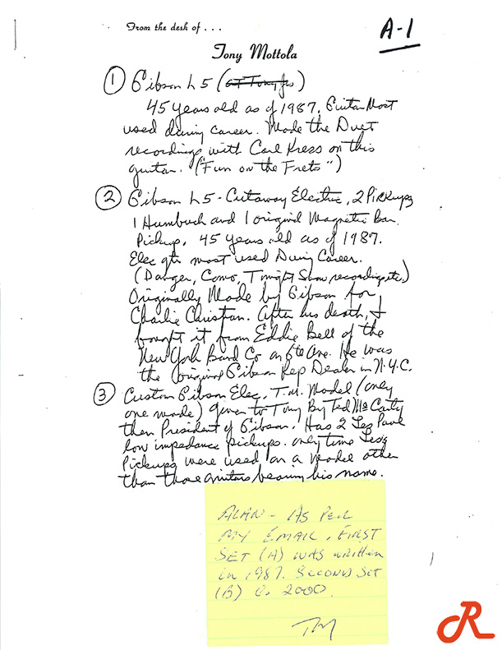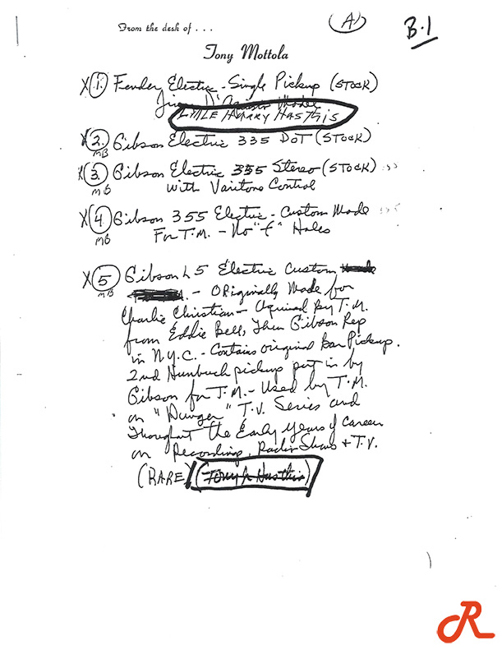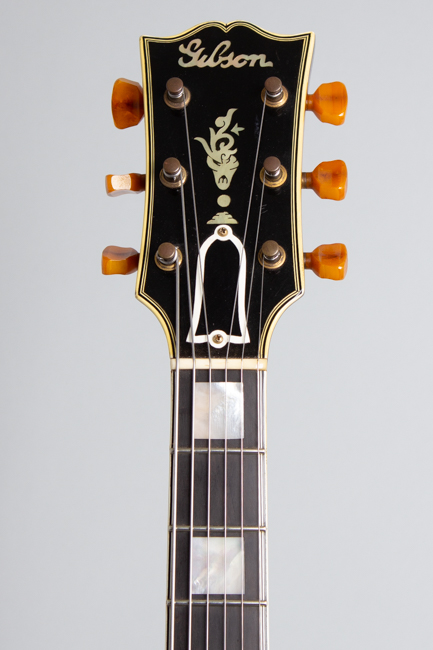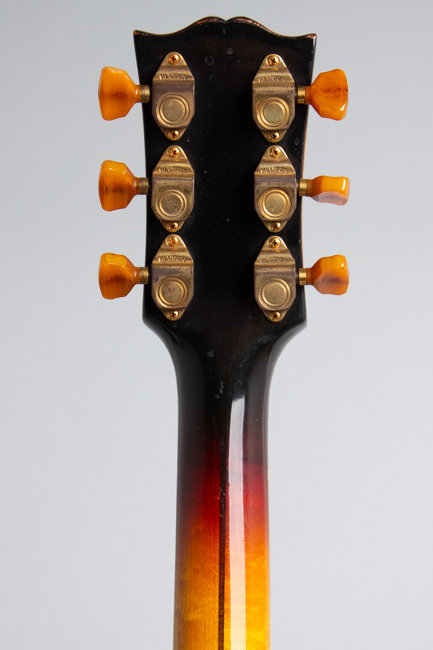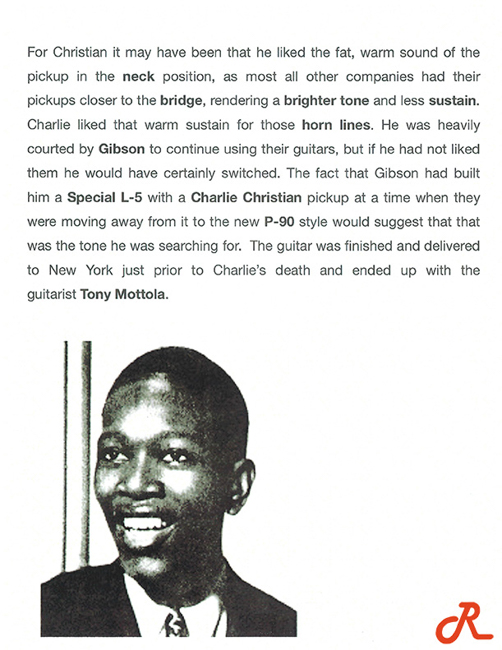Gibson L-5P owned and used by Tony Mottola Arch Top Hollow Body Electric Guitar (1940)
Gibson L-5P owned and used by Tony Mottola Model Arch Top Hollow Body Electric Guitar (1940), made in Kalamazoo, Michigan, serial # 96515, sunburst lacquer finish, maple back and sides with spruce top; laminated maple neck with ebony fingerboard, black hard shell case.
This electric L-5P is one of the most historically interesting and important guitars we have ever encountered, both for what it is and the players it is connected to. A purpose built fully-carved deluxe electric, it was originally intended for the most influential electric guitarist in jazz history: Charlie Christian. After Christian's untimely death it passed to a new young Gibson endorser, Tony Mottola, who used it for much of his long career. An electrified L-5P was NOT a stock model; Gibson never cataloged a carved, cutaway electric model prior to WWII and a handful at most were ever assembled.
The guitar carries factory order number 1343F-6 indicating it was built in 1940, a very early example of a cutaway L-5. It first appears in Gibson's shipping ledgers on June 28, 1941 alongside an EH-185 amplifier designated for "Chas. Christian (NY Band)". New York Band Instrument Company was Gibson's primary distributor in swing era Manhattan, with a warehouse on 6th Avenue between 45th and 46th streets Gibson used as a depot. Christian's playing had the major role in establishing the electric guitar as a jazz instrument; he initially used a Gibson ES-150 but had upgraded in mid-1940 to a fancier ES-250 shortly after that became available. This fully carved L-5P would have been the ultimate upgrade, as fine an electric guitar as could be made in 1941 equipped with the bar-magnet pickup Christian favored.
Tragically Christian had little time to make use of it; already stricken with tuberculosis, he was first treated at Seaview hospital on Staten Island the same month the guitar was sent. Despite optimistic reports of a recovery he died March 2, 1942, at age 25 and the guitar returned to Gibson.
It then appears in Gibson records shipped on April 21, 1942 to NY Band with an EH-185 amp for Tony Mottola, a new Gibson endorser at the time. It was notated as "L-5P 96515 ES-250 Pick Up" confirming it was built with a single bar magnet pickup in the neck position, something Gibson had already phased out on production instruments. Mottola appeared in Gibson's 1942 catalog "BB" with an ES-300, but this fully carved custom L-5 was a major upgrade, with the "outdated" pickup discerning players already preferred. Gibson production was feeling the pinch of WWII limitations, so Mottola was fortunate to get this set! Interestingly he at some point also received an NON-amplified L-5 P from the same batch, FON 1343F-9 with the sequential serial number 96516.
Mottola used the guitar extensively in the ensuing decades, especially in the 1940s and '50s. He himself called it his "most used" guitar. There are many photographs of him with the instrument, and it graced countless recordings. While a well known name, Mottola is perhaps less well remembered now than some more bop-oriented contemporaries. He began his career as a duet partner for the veteran Karl Cress, then served as sideman for big names in swing including Benny Goodman, Tommy Dorsey and Artie Shaw. He became one of the most sought-after session musicians from the later 1940s up into the '70s, most memorably with Frank Sinatra. This guitar was particularly featured on one of his most interesting and influential projects, the evocative score for the 1950-55 "Danger" TV series which set the pattern for the later "Peter Gunn" and James Bond guitar-centric soundtracks.
In 2021 Tony Mottola Jr. wrote: "My father was a Gibson endorser beginning in the 1940s, and a good friend of Ted McCarty who often sought his opinion on the company's new designs in the development stage." This guitar was the earliest and most lasting product of that endorsement. It was returned to Gibson at least twice for upgrades; in the 1940s a second bar magnet pickup was installed in the bridge position, an extremely rare fitting. This was replaced by a gold-plated patent # humbucker sometime in the '60s and the mounting screw holes in the lower top filled with pearl dots. At some point a thin black plastic ring was added around the original neck pickup.
The wiring rig has a single switch on the forward cutaway and standard dual tone and volume controls, fitted with late-50s gold knobs. The beautiful 1940 amber-button Kluson tuning pegs remain original, as do the engraved gold and silver tailpiece and multi-bound pickguard, trimmed at the back edge to clear the rear pickup. The ebony bridge was hand carved by Jimmy D'Aquisto and signed by him on the underside. Tony wrote his name in pencil on the label and the back under the bass side f-hole. The guitar has been refretted more than once, the frets and fingerboard showing virtually no wear.
There are a few old repairs; two old sealed grain splits to the top, one off the bottom of the treble F-hole and the other off the bass side back edge. The rim around the tailpiece has several sealed splits running up to the jack area, visible but not unsightly. The finish shows light signs of use; this is obviously a very well cared for instrument. This is not only a unique piece of Gibson (and American musical) history it remains 80+ years along a peerless instrument to play, with a superb feel and totally unique sound. It resides in a 1960s era Gibson case, and comes a detailed, extensive collection of images and artefacts documenting its history and provenance.
Overall length is 42 1/4 in. (107.3 cm.), 17 in. (43.2 cm.) wide at lower bout, and 3 3/8 in. (8.6 cm.) in depth, measured at side of rim. Scale length is 25 1/2 in. (648 mm.). Width of nut is 1 11/16 in. (43 mm.). Overall Excellent - Condition.
This electric L-5P is one of the most historically interesting and important guitars we have ever encountered, both for what it is and the players it is connected to. A purpose built fully-carved deluxe electric, it was originally intended for the most influential electric guitarist in jazz history: Charlie Christian. After Christian's untimely death it passed to a new young Gibson endorser, Tony Mottola, who used it for much of his long career. An electrified L-5P was NOT a stock model; Gibson never cataloged a carved, cutaway electric model prior to WWII and a handful at most were ever assembled.
The guitar carries factory order number 1343F-6 indicating it was built in 1940, a very early example of a cutaway L-5. It first appears in Gibson's shipping ledgers on June 28, 1941 alongside an EH-185 amplifier designated for "Chas. Christian (NY Band)". New York Band Instrument Company was Gibson's primary distributor in swing era Manhattan, with a warehouse on 6th Avenue between 45th and 46th streets Gibson used as a depot. Christian's playing had the major role in establishing the electric guitar as a jazz instrument; he initially used a Gibson ES-150 but had upgraded in mid-1940 to a fancier ES-250 shortly after that became available. This fully carved L-5P would have been the ultimate upgrade, as fine an electric guitar as could be made in 1941 equipped with the bar-magnet pickup Christian favored.
Tragically Christian had little time to make use of it; already stricken with tuberculosis, he was first treated at Seaview hospital on Staten Island the same month the guitar was sent. Despite optimistic reports of a recovery he died March 2, 1942, at age 25 and the guitar returned to Gibson.
It then appears in Gibson records shipped on April 21, 1942 to NY Band with an EH-185 amp for Tony Mottola, a new Gibson endorser at the time. It was notated as "L-5P 96515 ES-250 Pick Up" confirming it was built with a single bar magnet pickup in the neck position, something Gibson had already phased out on production instruments. Mottola appeared in Gibson's 1942 catalog "BB" with an ES-300, but this fully carved custom L-5 was a major upgrade, with the "outdated" pickup discerning players already preferred. Gibson production was feeling the pinch of WWII limitations, so Mottola was fortunate to get this set! Interestingly he at some point also received an NON-amplified L-5 P from the same batch, FON 1343F-9 with the sequential serial number 96516.
Mottola used the guitar extensively in the ensuing decades, especially in the 1940s and '50s. He himself called it his "most used" guitar. There are many photographs of him with the instrument, and it graced countless recordings. While a well known name, Mottola is perhaps less well remembered now than some more bop-oriented contemporaries. He began his career as a duet partner for the veteran Karl Cress, then served as sideman for big names in swing including Benny Goodman, Tommy Dorsey and Artie Shaw. He became one of the most sought-after session musicians from the later 1940s up into the '70s, most memorably with Frank Sinatra. This guitar was particularly featured on one of his most interesting and influential projects, the evocative score for the 1950-55 "Danger" TV series which set the pattern for the later "Peter Gunn" and James Bond guitar-centric soundtracks.
In 2021 Tony Mottola Jr. wrote: "My father was a Gibson endorser beginning in the 1940s, and a good friend of Ted McCarty who often sought his opinion on the company's new designs in the development stage." This guitar was the earliest and most lasting product of that endorsement. It was returned to Gibson at least twice for upgrades; in the 1940s a second bar magnet pickup was installed in the bridge position, an extremely rare fitting. This was replaced by a gold-plated patent # humbucker sometime in the '60s and the mounting screw holes in the lower top filled with pearl dots. At some point a thin black plastic ring was added around the original neck pickup.
The wiring rig has a single switch on the forward cutaway and standard dual tone and volume controls, fitted with late-50s gold knobs. The beautiful 1940 amber-button Kluson tuning pegs remain original, as do the engraved gold and silver tailpiece and multi-bound pickguard, trimmed at the back edge to clear the rear pickup. The ebony bridge was hand carved by Jimmy D'Aquisto and signed by him on the underside. Tony wrote his name in pencil on the label and the back under the bass side f-hole. The guitar has been refretted more than once, the frets and fingerboard showing virtually no wear.
There are a few old repairs; two old sealed grain splits to the top, one off the bottom of the treble F-hole and the other off the bass side back edge. The rim around the tailpiece has several sealed splits running up to the jack area, visible but not unsightly. The finish shows light signs of use; this is obviously a very well cared for instrument. This is not only a unique piece of Gibson (and American musical) history it remains 80+ years along a peerless instrument to play, with a superb feel and totally unique sound. It resides in a 1960s era Gibson case, and comes a detailed, extensive collection of images and artefacts documenting its history and provenance.
Overall length is 42 1/4 in. (107.3 cm.), 17 in. (43.2 cm.) wide at lower bout, and 3 3/8 in. (8.6 cm.) in depth, measured at side of rim. Scale length is 25 1/2 in. (648 mm.). Width of nut is 1 11/16 in. (43 mm.). Overall Excellent - Condition.
